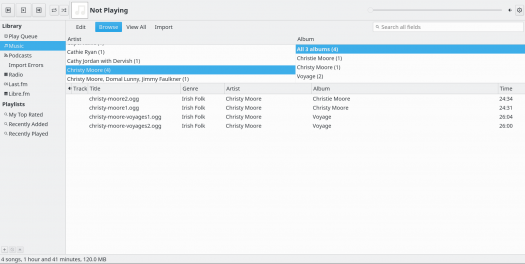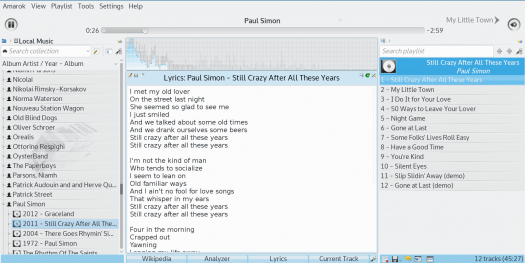
SOURCE: Pixabay
Posted on 05/22/2019 4:56:11 AM PDT by ShadowAce

SOURCE: Pixabay
Novelist Hugh MacLennan once described Canada as “two solitudes” — an English-speaking one and a French-speaking one, neither of which had much to do with the other. The description is decades out-dated, and today a dozen solitudes might be more accurate. However, the phrase echoes in my mind whenever I think of the gulf today between GNOME technologies and KDE software compilations. Although both are based on the Linux kernel, the expectations and philosophies are different enough that they might almost be different operating systems.
The difference has not always existed. When GNOME and KDE began in the late 1990s, both were scrambling hard to match desktops on other operating systems. Widgets aside, the differences were minimal. For years the two graphical interfaces regularly traded places on reader surveys, with perhaps a slight edge for GNOME, depending on the magazine or site conducting the survey. Flame wars could be fierce, but like many flame wars, the fierceness reflected how trivial the differences mostly were — at least, after KDE’s Qt toolkit became free software. The difference was largely one of branding.
Still, GNOME and KDE each slowly developed its own ecosystem of applications. A few applications like OpenOffice.org were shared, presumably because developing alternative for large applications was difficult. Moreover, the popularity of some apps like Firefox overwhelmed native alternatives like KDE’s Konqueror. But in categories like music-players, archivers, and CD burners, each slowly started to developed its own set of tools.
Differention accelerated midway through the first decade of the millennium. At that point, both GNOME and KDE had caught up with Windows, and each decided that the next step was to become a leader in desktop innovation. Broadly speaking, KDE 4.0, released in 2008, focused on adding features and logic that offered new productivity tools or extended basic tools. For example, the desktop had widgets added to it as well as “Activities,” multiple desktops that allow task-based work-flows, as well as other feature that allowed countless customizations.
By contrast, GNOME designers began the 3.0 release of 2011 with the concept of removing clutter from the desktops. Freshly installed, the GNOME desktop launches apps from an overscreen and runs them in system-managed virtual workspaces. Even more so than KDE, it pushed users to work in non-traditional ways.
Both releases were examples of how not to introduce innovation. Distributions pushed KDE 4.0 into their repositories before it was ready for general use, while GNOME 3.0 was too strict in the limitations it imposed on users. KDE responded to the criticism in the next two releases, and managed to retain most of its users. GNOME, however, was reluctant to abandon its vision of how its designers thought users should work. By the time GNOME released extensions that restored customization and allowed a Gnome 2 desktop under another name, much of its user base had moved on to other desktops, including Linux Mint’s GNOME-based Mate and Cinammon desktops. Many did not return.
Few deserting GNOME users seem to have considered KDE. Desktop-hopping became common, with most settling on desktops that used GNOME applications. Ever since about 2012, polls have regularly shown that while KDE Plasma has remained the single most popular desktop, used by 27-35% of Linux desktops users, GNOME apps are used by perhaps two-thirds of desktop users — although not usually the GNOME desktop. Few of each group of users have more than a passing idea of what the other is about.
After two decades, the differences between the two desktops are distinct. For instance, in order to eliminate desktop clutter the Gnome desktop discourages icons, while Plasma encourages a mixture of commands, URLs and folders on the desktop in order to customize Activities for specific tasks. An Activity for writing, for example, might have icons for storage folders, and URLs for a dictionary or thesaurus. Similarly, while GNOME’s overview locates and launches applications, Plasma’s displays all Activities. Plasma also has what I call a setup mode, from which settings can be altered directly from the desktop — something that has no counterpart in GNOME. And even with extenstions, GNOME does not match the customizations found in Plasma, which are so numerous that some users report discovering new ones after years of use.
However, the most obvious difference is in general design philosophy. GNOME is built on a minimalist philosophy, its windows displaying only the most commonly used functions, all thoughtfully positioned in relation to one another. The opposite approach is taken in Plasma, with each app containing all the tools that could possibly be needed for both the main purpose of the app and any possible side-purposes as well. In the past, this completist approach has sometimes left Plasma with some chaotic interfaces, including tabs marked General that were dumping grounds for features that do not fit somewhere else.
Today, though, Plasma has had several years of improvements by its design team, and the standards of interface design are markedly improved. digiKam, for one, is so well-designed that it actually has several sub-systems for managing and editing images, each with its own window.
The two philosophies often spill over into each ecosystem of apps. For example, both Rhythmbox and Amarok are music players, with all the tools needed to play and manage audio files, including play lists and ratings. However, Rhythmbox has few features beyond those basics, making it easy to learn from scratch. In every way, it is an intuitive applications, one that anyone with basic desktop experience can open and start using.

Rhythmbox music player
By contrast, Amarok does all that and more. In order to reproduce the experience of playing music at home, it has a context bar in the middle, where Wikipedia entries and concert calendars and links to lyric pages do their best to reproduce the experience of hard copy albums. It also includes plugins for easy access to podcasts and streaming services, a cover collection, and a mood bar that changes colors to fit the music. None of these features is essential to the basic act of listening to music, but those who want such features can have them.

Amarok music player
Compare other longstanding apps, and the different philosophies are just as obvious: K3B to Brasero, Okular to Evince, and many more. In both cases, the whole point is to provide a uniform computing experience, and modern GNOME and Plasma both do so with painstaking thoroughness.
Together, Plasma’s competist apps and GNOME’s minimalist apps leave only limited space for standalone apps. Increasingly, your desktop determines your toolset and your work-flow. It is unsurprising that switching between GNOME and Plasma is relatively rare, because if one set of apps suits you, the chances are that the other one will not.
Both GNOME and Plasma have grown greatly in sophistication in the last fifteen years, and the old criticisms of them have long ago ceased to apply. The next time someone — probably a Mac user — accuses the Linux desktop of poor design, tell them to look up the differences between GNOME and Plasma. Considerable experience has gone into improving the Linux desktop in recent years, and the result is two well-differentiated choices. And if you have been using one of these choices for a few years, take the time to look at the other one. You may be surprised by what you see.

XFCE over Gnome for me.
Plasma all the way.
I’ve been a XFCE guy for years now. I’m not real fond of Gnome, but I may give KDE a shot again.
When you use XFCE, the underpinning involves a lot of Gnome programs. The Gnome desktop seems awkward to me.
I used to be a Gnome guy, years ago when I was running ubuntu - then they switched to their "unity" interface and lost me.
That led to kubuntu, and dalliances with Mepis, PCLinuxOS, a fairly long run with Mint/KDE, and most recently KDE Neon as my primary home use distro. Work is RHEL through and through - currently with KDE, but rumor is sometime soon IT will only support Gnome...
I also use XFCE (on Debian).
Gnome is sluggish even with plenty of RAM and a quick processor. And it’s “minimal” interface really is not intuitive.
KBE might be good, or not, but I really don’t care. I just want to use my computer. I don’t want a “desktop”.
With the libraries installed you can still use any application you need. I use FreeCAD a lot and it uses KBE for it’s UI and it is fine. I also use some Gnome based apps.
Is there a reason they're going to drop KDE? Is that the preference of other admin's or something? Just curious.

Are you aware that Ubuntu made the swap back to gnome and dropped Unity?
That's not to say you can't run other desktops. It's just that RH will no longer support KDE.
Since RH won't support KDE IT depts will not either, because they cannot guarantee that they could solve *every* issue that crops up. If a KDE issue occurs, then the IT depts are on their own.
Most corporations don't like that idea. :)
Gnome Mahjong is essential. No KDE for me.
I'm disappointed that Mint is abandoning KDE, but I'll switch to XFCE which is pretty much always my second choice, and my first choice when in a VM, because it's a bit less of a heavyweight environment than KDE.
One of the things I really like about KDE is Dolphin, the GUI file manager. On those rare occasions that I find the GUI file manager to be desired, I like the way it does split screens, and the fact that it understands the 'fish://' nomenclature to browse remote filesystems.
I understand that you can get into flame wars when talking about a desktop environment, but I'm frankly happy that there are many alternatives available. Each person can use exactly what appeals most to them, without having any one perspective to force it's ideas of layout, and workflow upon everyone, (cough, Windows).
Now, if you want to get religious, lets talk about vi, and emacs!
Yup—gotta be vi, or vim, all the way.
Good Hunting... from Varmint Al
Thanks for the info. We have over 15,000 RHEL Servers and I’m sure this isn’t making our Admin’s very happy.
OMG, that's a holy war you do NOT want to start, ROFL!!!
Yeah, but I’ve got plenty of inertia.. :-)
I've always thought it was funny. I'm a VI guy, but also go with the Linux philosophy that "There's more than one way to do it", so I'm just appreciative that there ARE other tools.
Disclaimer: Opinions posted on Free Republic are those of the individual posters and do not necessarily represent the opinion of Free Republic or its management. All materials posted herein are protected by copyright law and the exemption for fair use of copyrighted works.